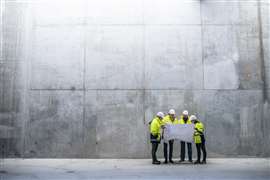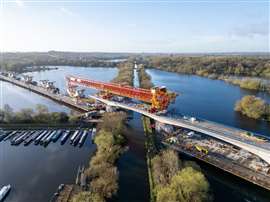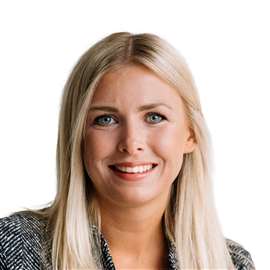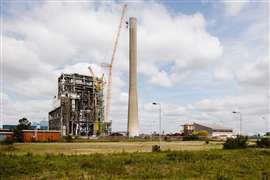Read this article in 中文 Français Deutsch Italiano Português Español
Why construction needs to look forward if it wants to handle uncertainty
14 October 2025
 Image: Halfpoint via AdobeStock - stock.adobe.com
Image: Halfpoint via AdobeStock - stock.adobe.com
Uncertainty has become the defining characteristic of global construction.
Whether it’s trade tariffs, political instability or shifting investment appetites, project pipelines in major markets are increasingly clouded by hesitation.
Last week construction buyers in the Eurozone and UK indicated that very point - the HCOB and S&P Global Construction PMIs both recorded falling activity in September, with respondents citing client caution and delayed decision-making as central causes.
This backdrop underscores the relevance of Currie & Brown’s new Construction Certainty Index. A global survey of 1,060 senior construction leaders designed to measure how well the industry manages risk, it launched at the end of last month.
The results suggest that uncertainty is not confined to any single geography or sector. Rather, it has become a structural feature of a globalised industry in which disruption in one market quickly ripples across others.
Speaking to Construction Briefing, Dr Alan Manuel, group chief executive of global construction and cost management consultants Currie & Brown, explains why the company developed the index, what it reveals about industry behaviour, and how construction can use data to improve its ability to plan ahead.
‘Uncertainty has become the norm’
 Dr Alan Manuel, Group CEO, Currie & Brown
Dr Alan Manuel, Group CEO, Currie & Brown
“When I started my career, everything was local,” says Manuel. “We made our own materials and used our own labour force. Now, a fire in a chipboard factory in China affects markets in the US, the UK and India. Risk has become global, and there’s no buffer in the system anymore.”
Labour shortages are compounding that lack of flexibility. “Everybody’s working to the maximum,” he says. “Any disruption has a big impact. And as an industry, we’re really good at measuring what’s happened in the past but not nearly as good at looking forward.”
It was this imbalance between retrospective analysis and forward-looking insight that prompted Currie & Brown to create a more systematic approach to measuring uncertainty. “We speak to clients across the world, and every conversation starts with, ‘We live in uncertain times.’ We felt that we needed to quantify that,” Manuel explains. “So we asked over a thousand senior decision-makers specific questions about where uncertainty lies in their projects.”
How the Index works
The Construction Certainty Index evaluates five key dimensions of project confidence: time and budget, risk, sustainability, technology adoption, and AI impact. These metrics emerged from consultation with industry participants.
“The pleasing thing,” says Manuel, “was that the list of issues identified by clients was almost identical to what we came up with internally. That told us we were focusing on the right areas.”
The first edition of the Index has found relatively narrow differences between sectors and geographies. Renewables emerged as the most certain sector, with an overall certainty score of 62 out of 100, while healthcare and hospitality were at the lower end with 54. Across regions, India and China topped the table on 61, while France ranked lowest at 49.
“The lack of spread is telling,” says Manuel. “Everybody’s facing the same problems - nobody has cracked this. Uncertainty is global.”
Building an industry benchmark
And the financial cost of uncertainty is huge.
The Index estimates that uncertainty could be constraining up to US$2.5 trillion in global construction activity. While no single company can eliminate that, Manuel believes the findings can help firms and clients focus their attention.
“It’s the old adage: You can’t manage what you can’t measure,” he says. “Having a way to pinpoint where uncertainty is most concentrated is important. But Currie & Brown can’t solve this alone; the industry needs to come together. We don’t need another glossy report telling us what the big issues are. We already know them. The problem is that we haven’t changed how we act.”
Policy, planning and political risk
Government processes and political cycles, he argues, remain a major source of uncertainty, particularly for large infrastructure programmes.
 Image: Zhu difeng via AdobeStock - stock.adobe.com
Image: Zhu difeng via AdobeStock - stock.adobe.com
“This isn’t just a UK problem,” says Manuel. “The UK may be at the extreme end when it comes to how long it takes to deliver social infrastructure, but it’s not unique. Germany announced €500 billion of investment, and it doesn’t look like much of that has been spent. In the US, you have federal and state governments not talking to each other, so essential social infrastructure projects are getting stuck.”
He adds that public investment in infrastructure should be viewed as a driver of economic stability, not as a political lever. “It sometimes feels like governments don’t understand that construction spend drives the economy. In most developed countries, it’s a huge proportion of GDP, yet few treat it seriously. We need to take social infrastructure away from politics.” He suggests establishing an independent body that decides national priorities and lets delivery professionals get on with the job.
That lack of long-term certainty in planning has consequences far beyond public works. “Every government has different priorities. You never know whether a project will be finished just because it’s started,” he says. “That’s not good for anybody.”
The technology factor
Among the Index’s most striking findings was the relationship between technology adoption and project certainty. Companies using artificial intelligence or advanced digital tools tended to report higher levels of predictability in outcomes.
While that might seem intuitive, Manuel says the underlying dynamic is more complex. “The certainty isn’t coming directly from AI,” he explains. “It’s that the organisations which are early adopters of technology tend to be better at managing risk and seeing the bigger picture. Those who could benefit most from AI are, paradoxically, the least likely to use it.”
He adds that while AI is widely discussed, practical applications in construction remain limited. “We talk a good game about AI, but the tools are still fairly basic. Those who are adopting it are doing so because they have the culture and systems in place to manage uncertainty better.”
‘The problems are global’
For Manuel, the global consistency of the Index results was as telling as any individual score. “I was expecting to see pockets of good practice and poor practice,” he says. “But everywhere, the
 Bouygues Construction are involved with the construction of the Colne Valley Viaduct as part of HS2 (Photo: HS2)
Bouygues Construction are involved with the construction of the Colne Valley Viaduct as part of HS2 (Photo: HS2)
themes are the same. The shortage of people in construction is a universal problem. Partly that’s a legacy of the pandemic - you can’t work from home on a construction site, so the sector has become even less attractive to new entrants.”
He believes that without coordinated action, these pressures will only intensify. “If we don’t do something, the problems are going to get worse. The industry needs to get its act together and start to sort this.”
For now, he hopes the Construction Certainty Index will provide a rare snapshot of how construction leaders view the risks ahead and a foundation for tackling them more systematically.
Currie & Brown intends to make the Index a recurring benchmark for measuring confidence and risk exposure, although its frequency has yet to be determined.
“We’ll definitely go back to those same respondents,” he says. “We had great access to senior decision-makers, and there’s no point in getting 1,060 good responses the first time and 30 the next. We want this to be a benchmark for the industry.”
STAY CONNECTED


Receive the information you need when you need it through our world-leading magazines, newsletters and daily briefings.
CONNECT WITH THE TEAM











